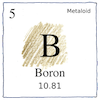London, Paris—Humphry Davy, Joseph Louis Gay-Lussac, Louis Jacques Thénard
elements

|
Boron
Humphry Davy used electrolysis on a solution of borates, detecting a brown precipitate that would have been pure boron, but found that chemistry alone, using potassium and heat to reduce boric acid, made faster work, upon which he declared the metal boracium. * Meanwhile, Joseph Louis Gay-Lussac and Louis Jacques Thénard used iron and high temperatures to reduce boric acid to boron and then showed that the boron could be recomposed into boric acid by exposure to air, upon which they declared the metal bore.
Atomic number 5
Sodium borates known as borax are water soluble so have collected in seasonally dry lakes. Boric acid is an antiseptic insecticide anti-fungal fertilizing flame retardant etcetera etcetera. Some Chinese glazes from 300 CE included borax introduced to Italy by Marco Polo. Used in laundry and hand soaps borax became a household name after 1883 due to William Tell Coleman”s 20 Mule Team Borax mined in Death Valley and later the sponsor of Death Valley Days.
Flubber
Modern miracles through chemistry include table-top polymerization of Elmer’s glue and borax a non-Newtonian fluid and Maxwell solid also signifies bungling.



Boron is a key element in high-temperature superconductors, thermal-shock-resistant glass for baking dishes and measuring cups, and an essential nutrient for plants and animals.
See also in The book of science:
Readings in wikipedia:
Other readings: